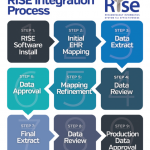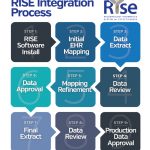In 2018, all providers will have to submit an entire year’s worth of their quality measure data to the CMS. After 2017, the transition year, the requirements and performance thresholds begin to increase.
The CMS is still heavily incentivizing participation in a Qualified Clinical Data Registry (QCDR), such as the RISE registry, for reporting in MIPS. There are still many bonuses to help providers increase their scores and protect themselves from penalties in the 2018 performance year.
More Exempt Providers in 2018
The CMS has increased the low-volume threshold, which will exclude more providers from reporting in 2018. Rheumatologists will be excluded from MIPS reporting if they have ≤$90,000 in Part B allowed charges or ≤200 Part B beneficiaries.
MIPS Composite Score
Under MACRA, the quality of care you provide will be determined by the “MIPS composite score.” Because this law must be budget neutral, there must be winners and losers. To do this, the CMS will determine the average score of providers; anyone above that score will get bonuses while providers below it will get a penalty. The various degrees of bonuses and penalties are determined by how many standard deviations you are away from the CMS’ determined average.
The MIPS composite score comprises four categories:
- Quality (replaces PQRS): 50%
- Clinical practice improvement activities (new category): 15%
- Advancing care information (replaces meaningful use): 25%
- Cost (replaces the value-based modifier): 10%
One positive change in the final scoring is the small practice bonus: The CMS will be adding five points to the final score of all practices that have 15 or fewer providers.
Help Your Scores with RISE
Another positive in this process: You can raise your scores by using the RISE registry. Following are a couple examples of what to do.
Quality
For 2018, providers must report on 60% of all their patients, regardless of payers. Providers will be scored on their best six measures, one of which must be an outcome/high-priority measure. This is made easy by the RISE registry, because the data used for reporting on these quality measures are extracted electronically and do not have to be entered by the provider.
The RISE registry will have a total of 18 measures: two of which are an outcome measure and another six are high-priority measures. In addition, one of the ACR’s own quality measures, ACR7, has been designated as an outcome measure for 2018. This means that rheumatology now has its own outcome measure for reporting for the first time in Quality reporting.
RISE will also be able to give providers the maximum 11 bonus points in the Quality category. Six points come from what is known as the end-to-end bonus, because all measures are electronically extracted, and providers will receive two points for an additional outcome measure and one point for each additional high-priority measure.
Clinical Practice Improvement Activities (CPIA)
This category consists of 90 activities that practices will complete through attestation. Of these 90 activities, practices will attempt to reach a score of 40 points with activities weighted differently. There are two weights for scoring under CPIA: medium = 10 points and high = 20 points. Providers will have to attest that they have completed these activities for a minimum of 90 days. If you are considered a small practice (15 providers or fewer), you will only be required to complete half of the points (20 points).
Participation in a QCDR registry, such as RISE, allows you to collect 30 points immediately through two population-management activities:
- Use of a QCDR to generate regular performance feedback that summarizes local practice patterns and treatment outcomes, including for vulnerable populations.
- Weighting: high; 20 points
- Participation in a QCDR, clinical data registries or other registries run by other government agencies, such as the FDA, or private entities, such as a hospital or medical or surgical society. Activity must include use of QCDR data for quality improvement (e.g., comparative analysis across specific patient populations for adverse outcomes after an outpatient surgical procedure and corrective steps to address adverse outcome).
- Weighting: medium; 10 points
For a full list of CPIAs, visit the CMS website.
Advancing Care Information (ACI)
This category will largely be dependent on the individual practice’s electronic health record (EHR) system. By participating in a QCDR like RISE, you are eligible for a 5% bonus in this category.
You will have to complete one of two options for ACI:
- Advancing Care Information Objectives and Measures
- 2017 Advancing Care Information Transition Objectives and Measures
How far your practice was along in Meaningful Use will determine which of two pathways you will take to satisfy this category:
You can report the Advancing Care Information Objectives and Measures:
- If you have technology certified to the 2015 edition; or
- If you have a combination of technologies from 2014 and 2015 editions that support these measures.
You can report the 2017 Advancing Care Information Transition Objectives and Measures:
- If you have technology certified to the 2014 edition; or
- If you have technology certified to the 2015 edition; or
- If you have a combination of technologies from 2014 and 2015 editions.
Resources for 2018 Readiness
For help identifying your EHR edition or if you’d like to learn more about this category, visit the Advancing Care Information page. For general QPP information, visit the CMS website.
If you are interested in joining RISE or have questions about the payment program in 2017, please contact ACR staff at [email protected].

